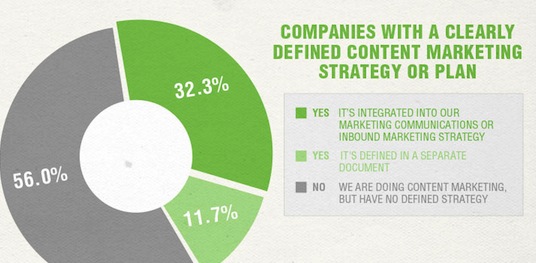[ad_1]
Content marketing was the top digital marketing buzzword of 2014. Every publisher, marketer, SEO strategist and agency couldn’t stop talking about it.
We all needed infographics and listicles and whitepapers and e-books and video (we cannot forget about VIDEO!!!). And it needed to be snackable! And we were going to curate and newsjack! And automate everything and do real-time marketing!
It was going to be amazing. So, what happened?
The Disconnect Between Content Marketing Strategy and Execution
According to Curata’s “Content Marketing Tactics Planner”, 71% of companies in 2014 planned on increasing their content marketing budgets, but 57% said they did not have a team member who was directly responsible for content strategy. You can see how things didn’t go exactly as planned.
It turns out, content marketing is more than just making more content – it means hiring more content creators, developing a strategy, planning more promotion, and investing in tools to share and organize all those new, shiny assets. And then there’s the whole business of finding someone to actually manage the entire process.
Read: Assets: Just Some Files, or Something More?
Ultimately, what we saw last year was a disconnect between content marketing strategy and execution, which resulted in a lot of missed goals and surprising findings – if any. Marketers failed to clearly define their goals and were completely overwhelmed with the sheer volume of content for owned, paid and earned channels.
I’d like to say things are looking up, but a recent survey from Smart Insights found that 56% of marketers did not have a defined marketing strategy or plan and only 11% have a completely separate content marketing plan that lives outside communications or inbound marketing strategy.

If we want to tame the beast that is content marketing, we need to invest in tools that allow us to measure effectiveness, produce consistent engaging content and manage a large arsenal of digital assets.
Shifting From Brand Publishing to Media Publishing
Content cannot be created in a silo and marketers need to focus on integrating content creation teams. Most importantly, marketers must stop hoarding digital assets in emails, agency servers and desktop files.
There needs to be a shift from basic brand publishing to functioning like a full-fledged media company. This means publishing content to multiple channels in real-time and optimizing the customer experience at every touch point, which requires seamless, integrated Digital Asset Management (DAM).
Read: Your Product Isn’t Unique — But Is It Distinct?
Think of it this way: How can you delight customers when Debbie from sales is using last year’s pricing guide? How can you awe and inspire your audience when Kevin from the social team pushes out graphics from six months ago? And how can you stay on budget when you keep recreating assets over and over again because no one can find anything?
Content Marketing Needs a DAM Plan
If you want your content marketing strategy to drive results, you need a DAM plan! In order to deliver content in an authentic and strategic way, you’ve got to stay organized.
*Read: Should Your Brand Identity Be More Responsive? *
Digital hoarding is expensive, inefficient, time-consuming and ineffective. Smart content marketing needs a vision and strategy and the technology to make it happen. A DAM solution allows marketers to manage the sheer volume of content landing in their laps.
Here are 4 ways a DAM plan supports content marketing:
- Integration: When marketers use DAM, they can create a seamless customer experience by delivering more content in a more timely and fluid manner.
- Optimization: With DAM, marketers can ensure each asset is being used in the right way at the right time for the right audience. They finally have control over the sea of assets in their organization.
- Collaboration: Whether it’s getting design updates from creative, new copy from writers, or high level approval, teams who use DAM are more agile, responsive and proactive in delivering on needs.
- Accessibility: DAM solutions give teams across distinct channels the ability to contribute to one centralized digital asset management solution – no more storing assets in emails or desktop files.
New DAM Vs. Old DAM Part of the reason content marketers haven’t adopted DAM systems is that they are traditionally expensive, clunky and difficult to implement. Old DAM systems typically move very slowly in a governed way, meaning one person acts as a gatekeeper and manages the entire system.
Old DAM: 
New DAM is different. New DAM solutions, like Brandfolder (time to toot our own horn here), are simple, easy to manage and offer a much more user-friendly interface.
New DAM isn’t as cost-prohibitive and offers more flexibility – users aren’t bogged down by expensive, clunky systems that are hard to use. The shift from old DAM to new DAM allows companies to adapt quickly to the new world of multichannel, real-time marketing.

And it doesn’t stop there: new DAM makes real-time advertising and programmatic buying more effective because there will be more access to relevant digital content that can be published at a much higher velocity.
Ultimately, DAM solutions are going to bring together all organizations to create a cohesive customer experience. From brand management to creative to social media to legal, teams across organizations will be able to collaborate and optimize every digital asset that shapes the buyer’s journey. And content marketing will be the light that shines the way.
Interested in discovering New DAM? Get your customized Brandfolder quote today.
*Morgan Quinn is a recovering lifestyle blogger and the Digital Content Manager for Brandfolder, a simple and easy tool for managing digital brand assets. She has created content for brands like Mint.com, Quicken, Ugg Australia, and Martha Stewart. She threw in the towel on Twitter, so follow her on LinkedIn instead. *
Source link






